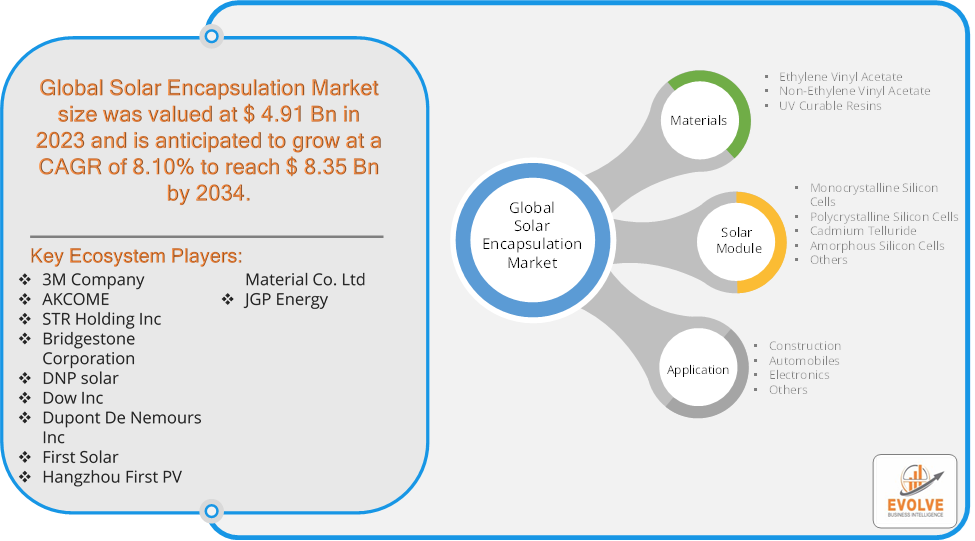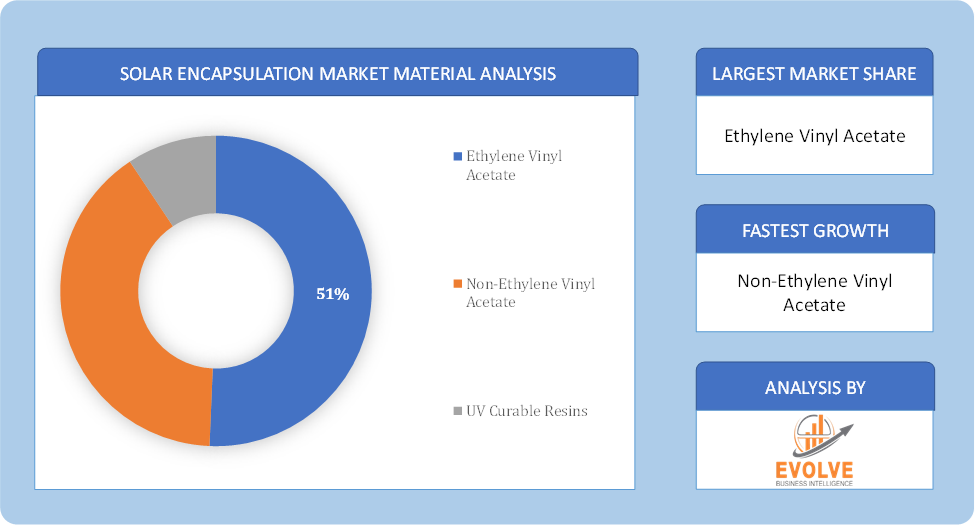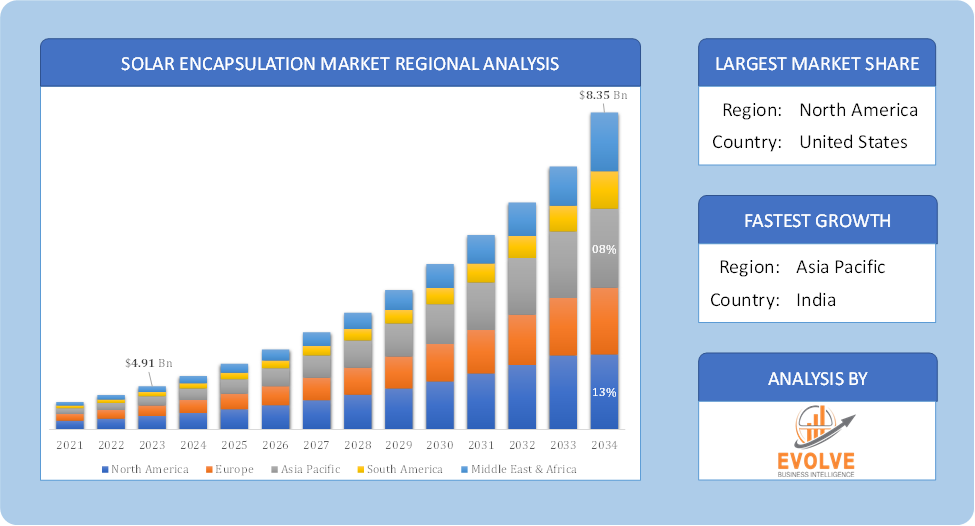Solar Encapsulation Market Analysis and Global Forecast 2023-2033
$ 1,390.00 – $ 5,520.00Price range: $ 1,390.00 through $ 5,520.00
Solar Encapsulation Market Research Report: Information By Materials (Ethylene Vinyl Acetate, Non-Ethylene Vinyl Acetate, UV Curable Resins), By Solar Module (Monocrystalline Silicon Cells, Polycrystalline Silicon Cells, Cadmium Telluride, Amorphous Silicon Cells, Others), By Application (Construction, Automobiles, Electronics, Others), and by Region — Forecast till 2034
Page: 167
Solar Encapsulation Market Overview
The Solar Encapsulation Market size accounted for USD 4.91 Billion in 2023 and is estimated to account for 5.17 Billion in 2024. The Market is expected to reach USD 8.35 Billion by 2034 growing at a compound annual growth rate (CAGR) of 8.10% from 2024 to 2034. The solar encapsulation market refers to the process of enclosing photovoltaic (PV) solar cells within protective materials to enhance their durability, performance, and longevity. It involves the use of various encapsulation materials, such as backsheets, encapsulants, and front sheets, to shield the solar cells from environmental factors and mechanical stress.
The market is driven by the increasing demand for renewable energy sources, particularly solar power, as well as technological advancements in solar PV modules. Encapsulation plays a crucial role in ensuring the long-term reliability and efficiency of solar power systems.
Global Solar Encapsulation Market Synopsis
 Solar Encapsulation Market Dynamics
Solar Encapsulation Market Dynamics
The major factors that have impacted the growth of Solar Encapsulation Market are as follows:
Drivers:
Ø Rising Demand for Solar Energy
The global push towards renewable energy to reduce carbon emissions and reliance on fossil fuels is increasing the adoption of solar power. This, in turn, drives the need for solar encapsulation materials to ensure the longevity and performance of solar panels. Innovations in solar panel design, efficiency improvements, and the development of advanced encapsulation materials (e.g., UV-resistant, weatherproof, and durable materials) are encouraging greater investments in solar energy projects, driving the encapsulation market. The declining cost of solar panel manufacturing, due to technological advancements and economies of scale, has made solar energy more affordable. This cost reduction is leading to wider adoption of solar panels, increasing the need for reliable encapsulation solutions.
Restraint:
- Perception of High Initial Costs and Complex Manufacturing Process
The production of high-quality solar encapsulation materials, especially those with enhanced durability and performance, can be expensive. This increases the overall cost of solar panels, which may slow adoption, particularly in cost-sensitive markets. The process of encapsulating solar cells is technically complex and requires precise handling. This can increase production times and costs, making it more difficult for manufacturers to scale up operations efficiently, especially in developing markets.
Opportunity:
⮚ Advancements in Encapsulation Materials
The development of advanced encapsulation materials with enhanced UV resistance, thermal stability, moisture resistance, and longer lifespans represents a key opportunity. Innovations such as silicone-based or multi-layer encapsulants can significantly improve the performance of solar modules, leading to increased adoption. Bifacial solar modules, which capture sunlight on both sides of the panel, are gaining popularity due to their higher energy efficiency. These panels require specialized encapsulation materials that offer transparency on both sides and excellent protection, opening a niche market for innovative encapsulation products.
Solar Encapsulation Market Segment Overview
Based on Materials, the market is segmented based on Ethylene Vinyl Acetate, Non-Ethylene Vinyl Acetate and UV Curable Resins. The Ethylene Vinyl Acetate segment dominant the Solar Encapsulation market due to its proven reliability, excellent adhesion properties, and compatibility with various solar panel technologies, enhancing overall module performance and longevity.
By Solar Module
Based on Solar Module, the market segment has been divided into Monocrystalline Silicon Cells, Polycrystalline Silicon Cells, Cadmium Telluride, Amorphous Silicon Cells and Others. The Polycrystalline Silicon Solar segment is expected to hold the largest market share in the Solar Encapsulation market due to its cost-effectiveness and widespread use in solar panel manufacturing, catering to a broad consumer base seeking affordable solar energy solutions.
By Application
Based on Application, the market segment has been divided into Construction, Automobiles, Electronics and Others. The Construction segment is expected to hold the largest market share in the Solar Encapsulation market due to the rising integration of solar panels into building designs and the increasing demand for sustainable and energy-efficient construction practices.
Global Solar Encapsulation Market Regional Analysis
Based on region, the global Solar Encapsulation Market has been divided into North America, Europe, Asia-Pacific, the Middle East & Africa, and Latin America. North America is projected to dominate the use of the Solar Encapsulation Market followed by the Asia-Pacific and Europe regions.
 Solar Encapsulation North America Market
Solar Encapsulation North America Market
North America holds a dominant position in the Solar Encapsulation Market. North America is important region for solar encapsulation. The region’s growth is driven by increasing environmental awareness, government support for renewable energy, and technological advancements in solar PV modules and the U.S. is a key player in the North American solar encapsulation market. Increasing solar installations, particularly in states like California, Texas, and Florida, are driving the need for encapsulation materials. The U.S. is also home to several solar technology innovators, creating demand for advanced encapsulation solutions.
Solar Encapsulation Asia-Pacific Market
The Asia-Pacific region has indeed emerged as the fastest-growing market for the Solar Encapsulation Market industry. The Asia-Pacific region dominates the solar encapsulation market, driven by countries like China, India, Japan, and South Korea. China is a significant driver of demand for encapsulation materials. The country’s government has set aggressive targets for renewable energy adoption, leading to massive solar PV installations and also India’s push towards solar energy, with ambitious programs like the National Solar Mission, is fueling demand for encapsulation materials to meet the growing installations of solar projects.
Competitive Landscape
The global Solar Encapsulation Market is highly competitive, with numerous players offering a wide range of software solutions. The competitive landscape is characterized by the presence of established companies, as well as emerging startups and niche players. To increase their market position and attract a wide consumer base, the businesses are employing various strategies, such as product launches, and strategic alliances.
Prominent Players:
- 3M Company
- AKCOME
- STR Holding Inc
- Bridgestone Corporation
- DNP solar
- Dow Inc
- Dupont De Nemours Inc
- First Solar
- Hangzhou First PV Material Co. Ltd
- JGP Energy
Key Development
In October 2023, Shanghai-based AIKO launched its cutting-edge solar cell products, including solar encapsulation technology, in Australia at the All-Energy exhibition in Melbourne.
In March 2023, the Chemical conglomerate DOW, a US-based company, launched photovoltaic (PV) product solutions for PV module assembly and line with six silicone-based sealants.
Scope of the Report
Global Solar Encapsulation Market, by Materials
- Ethylene Vinyl Acetate
- Non-Ethylene Vinyl Acetate
- UV Curable Resins
Global Solar Encapsulation Market, by Solar Module
- Monocrystalline Silicon Cells
- Polycrystalline Silicon Cells
- Cadmium Telluride
- Amorphous Silicon Cells
- Others
Global Solar Encapsulation Market, by Application
- Construction
- Automobiles
- Electronics
- Others
Global Solar Encapsulation Market, by Region
- North America
- US
- Canada
- Mexico
- Europe
- UK
- Germany
- France
- Italy
- Spain
- Benelux
- Nordic
- Rest of Europe
- Asia Pacific
- China
- Japan
- South Korea
- Indonesia
- Austalia
- Malaysia
- India
- Rest of Asia Pacific
- South America
- Brazil
- Argentina
- Rest of South America
- Middle East & Africa
- Saudi Arabia
- UAE
- Egypt
- South Africa
- Rest of Middle East & Africa
| Parameters | Indicators |
|---|---|
| Market Size | 2034: USD 8.35 Billion |
| CAGR (2024-2034) | 8.10% |
| Base year | 2022 |
| Forecast Period | 2024-2034 |
| Historical Data | 2021 (2017 to 2020 On Demand) |
| Report Coverage | Revenue Forecast, Competitive Landscape, Growth Factors, and Trends |
| Key Segmentations | Material, Solar Module, Application |
| Geographies Covered | North America, Europe, Asia-Pacific, South America, Middle East, Africa |
| Key Vendors | 3M Company, AKCOME, STR Holding Inc, Bridgestone Corporation, DNP solar, Dow Inc, Dupont De Nemours Inc, First Solar, Hangzhou First PV Material Co. Ltd and JGP Energy |
| Key Market Opportunities | · Advancements in Encapsulation Materials
· Rising Adoption of Bifacial Solar Modules |
| Key Market Drivers | · Rising Demand for Solar Energy
· Technological Advancements in Solar PV Technology |
REPORT CONTENT BRIEF:
- High-level analysis of the current and future Solar Encapsulation Market trends and opportunities
- Detailed analysis of current market drivers, restraining factors, and opportunities in the future
- Solar Encapsulation Market historical market size for the year 2021, and forecast from 2023 to 2033
- Solar Encapsulation Market share analysis at each product level
- Competitor analysis with detailed insight into its product segment, Government & Defense strength, and strategies adopted.
- Identifies key strategies adopted including product launches and developments, mergers and acquisitions, joint ventures, collaborations, and partnerships as well as funding taken and investment done, among others.
- To identify and understand the various factors involved in the global Solar Encapsulation Market affected by the pandemic
- To provide a detailed insight into the major companies operating in the market. The profiling will include the Government & Defense health of the company’s past 2-3 years with segmental and regional revenue breakup, product offering, recent developments, SWOT analysis, and key strategies.
Press Release

Global Pharmaceutical Manufacturing Market to Reach $1.38 Trillion by 2035 with 7.35% CAGR, New Research Shows

The Global Mammography Market Is Estimated To Record a CAGR of Around 10.29% During The Forecast Period

Glue Stick Market to Reach USD 2.35 Billion by 2034

Podiatry Service Market to Reach USD 11.88 Billion by 2034

Microfluidics Technology Market to Reach USD 32.58 Billion by 2034

Ferric Chloride Market to Reach USD 10.65 Billion by 2034

Family Practice EMR Software Market to Reach USD 21.52 Billion by 2034

Electric Hairbrush Market to Reach USD 15.95 Billion by 2034

Daily Bamboo Products Market to Reach USD 143.52 Billion by 2034

Cross-border E-commerce Logistics Market to Reach USD 112.65 Billion by 2034
Frequently Asked Questions (FAQ)
What is the study period of this market?
The study period of the global Solar Encapsulation Market is 2021- 2033
What is the growth rate of the global Solar Encapsulation Market?
The global Solar Encapsulation Market is growing at a CAGR of 8.10% over the next 10 years
Which region has the highest growth rate in the market of Solar Encapsulation Market?
Asia Pacific is expected to register the highest CAGR during 2024-2034
Which region has the largest share of the global Solar Encapsulation Market?
North America holds the largest share in 2022
Who are the key players in the global Solar Encapsulation Market?
3M Company, AKCOME, STR Holding Inc, Bridgestone Corporation, DNP solar, Dow Inc, Dupont De Nemours Inc, First Solar, Hangzhou First PV Material Co. Ltd and JGP Energy are the major companies operating in the market.
Do you offer Post Sale Support?
Yes, we offer 16 hours of analyst support to solve the queries
Do you sell particular sections of a report?
Yes, we provide regional as well as country-level reports. Other than this we also provide a sectional report. Please get in contact with our sales representatives.
Table of Content
CHAPTER 1. Executive Summary CHAPTER 2. Scope of the Study 2.1. Market Definition 2.2. Market Scope & Segmentation 2.2.1. Objective of Report CHAPTER 3. Evolve BI Methodology 3.1. Data Collection & Validation Approach 3.2. Market Size Estimation and Forecast CHAPTER 4. Exclusive Analysis 4.1. Market Opportunity Score 4.1.1. Material Segement – Market Opportunity Score 4.1.2. Solar Module Segment – Market Opportunity Score 4.1.3. Application Segment – Market Opportunity Score 4.2. Key Market Influencing Indicators CHAPTER 5. Market Insights and Trends 5.1. Value Chain Analysis 5.1.1. Raw Material 5.1.2. Manufacturing Process 5.1.3. Distribution Channel 5.1.4. End User 5.2. Porter’s Five Forces Analysis 5.2.1. Bargaining Power of Buyers 5.2.2. Bargaining Power of Suppliers 5.2.3. Threat of New Entrant 5.2.4. Threat of Substitute 5.2.5. Industry Rivalry 5.3. COVID-19 Impact and Post COVID Scenario on Solar Encapsulation Market 5.3.1. Impact of COVID-19 5.3.2. Government Support and Industry Revival Policies 5.3.3. Measures Taken by Companies to Mitigate Negative Impact 5.3.4. Post COVID Trend CHAPTER 6. Market Dynamics 6.1. Introduction 6.2. Drivers 6.2.1. Driver 1 6.2.2. Driver 2 6.2.3. Driver 3 6.3. Restraints 6.3.1. Restraint 1 6.3.2. Restraint 2 6.4. Opportunity 6.4.1. Opportunity 1 CHAPTER 7. Solar Encapsulation Market, By Material 7.1. Introduction 7.1.1. Ethylene Vinyl Acetate 7.1.2. Non-Ethylene Vinyl Acetate 7.1.3 UV Curable Resins CHAPTER 8 Solar Encapsulation Market, By Solar Module 8.1. Introduction 8.1.1. Monocrystalline Silicon Cells 8.1.2. Polycrystalline Silicon Cells 8.1.3. Cadmium Telluride 8.1.4. Amorphous Silicon Cells 8.1.5. Others CHAPTER 9. Solar Encapsulation Market, By Application 9.1. Introduction 9.1.1. Construction 9.1.2 Automobiles 9.1.3 Electronics 9.1.4. Others CHAPTER 10. Solar Encapsulation Market, By Region 10.1. Introduction 10.2. NORTH AMERICA 10.2.1. North America: Market Size and Forecast, By Country, 2024 – 2034($ Million) 10.2.2. North America: Market Size and Forecast, By Solar Module, 2024 – 2034($ Million) 10.2.3. North America: Market Size and Forecast, By Material, 2024 – 2034($ Million) 10.2.4. North America: Market Size and Forecast, By Application, 2024 – 2034($ Million) 10.2.5. US 10.2.5.1. US: Market Size and Forecast, By Solar Module, 2024 – 2034($ Million) 10.2.5.2. US: Market Size and Forecast, By Material, 2024 – 2034($ Million) 10.2.5.3. US: Market Size and Forecast, By Application, 2024 – 2034($ Million) 10.2.6. CANADA 10.2.6.1. Canada: Market Size and Forecast, By Solar Module, 2024 – 2034($ Million) 10.2.6.2. Canada: Market Size and Forecast, By Material, 2024 – 2034($ Million) 10.2.6.3. Canada: Market Size and Forecast, By Application, 2024 – 2034($ Million) 10.2.7. MEXICO 10.2.7.1. Mexico: Market Size and Forecast, By Solar Module, 2024 – 2034($ Million) 10.2.7.2. Mexico: Market Size and Forecast, By Material, 2024 – 2034($ Million) 10.2.7.3. Mexico: Market Size and Forecast, By Application, 2024 – 2034($ Million) 10.3. Europe 10.3.1. Europe: Market Size and Forecast, By Country, 2024 – 2034($ Million) 10.3.2. Europe: Market Size and Forecast, By Solar Module, 2024 – 2034($ Million) 10.3.3. Europe: Market Size and Forecast, By Material, 2024 – 2034($ Million) 10.3.4. Europe: Market Size and Forecast, By Application, 2024 – 2034($ Million) 10.3.5. U.K. 10.3.5.1. U.K.: Market Size and Forecast, By Solar Module, 2024 – 2034($ Million) 10.3.5.2. U.K.: Market Size and Forecast, By Material, 2024 – 2034($ Million) 10.3.5.3. U.K.: Market Size and Forecast, By Application, 2024 – 2034($ Million) 10.3.6. GERMANY 10.3.6.1. Germany: Market Size and Forecast, By Solar Module, 2024 – 2034($ Million) 10.3.6.2. Germany: Market Size and Forecast, By Material, 2024 – 2034($ Million) 10.3.6.3. Germany: Market Size and Forecast, By Application, 2024 – 2034($ Million) 10.3.7. FRANCE 10.3.7.1. France: Market Size and Forecast, By Solar Module, 2024 – 2034($ Million) 10.3.7.2. France: Market Size and Forecast, By Material, 2024 – 2034($ Million) 10.3.7.3. France: Market Size and Forecast, By Application, 2024 – 2034($ Million) 10.3.8. ITALY 10.3.8.1. Italy: Market Size and Forecast, By Solar Module, 2024 – 2034($ Million) 10.3.8.2. Italy: Market Size and Forecast, By Material, 2024 – 2034($ Million) 10.3.8.3. Italy: Market Size and Forecast, By Application, 2024 – 2034($ Million) 10.3.9. SPAIN 10.3.9.1. Spain: Market Size and Forecast, By Solar Module, 2024 – 2034($ Million) 10.3.9.2. Spain: Market Size and Forecast, By Material, 2024 – 2034($ Million) 10.3.9.3. Spain: Market Size and Forecast, By Application, 2024 – 2034($ Million) 10.3.10. BENELUX 10.3.10.1. BeNeLux: Market Size and Forecast, By Solar Module, 2024 – 2034($ Million) 10.3.10.2. BeNeLux: Market Size and Forecast, By Product, 2024 – 2034($ Million) 10.3.10.3. BeNeLux: Market Size and Forecast, By Application, 2024 – 2034($ Million) 10.3.11. RUSSIA 10.3.11.1. Russia: Market Size and Forecast, By Solar Module, 2024 – 2034($ Million) 10.3.11.2. Russia: Market Size and Forecast, By Material, 2024 – 2034($ Million) 10.3.11.3. Russia: Market Size and Forecast, By Application, 2024 – 2034($ Million) 10.3.12. REST OF EUROPE 10.3.12.1. Rest of Europe: Market Size and Forecast, By Solar Module, 2024 – 2034($ Million) 10.3.12.2. Rest of Europe: Market Size and Forecast, By Material, 2024 – 2034($ Million) 10.3.12.3. Rest of Europe: Market Size and Forecast, By Application, 2024 – 2034($ Million) 10.4. Asia Pacific 10.4.1. Asia Pacific: Market Size and Forecast, By Country, 2024 – 2034($ Million) 10.4.2. Asia Pacific: Market Size and Forecast, By Solar Module, 2024 – 2034($ Million) 10.4.3. Asia Pacific: Market Size and Forecast, By Material, 2024 – 2034($ Million) 10.4.4. Asia Pacific: Market Size and Forecast, By Application, 2024 – 2034($ Million) 10.4.5. CHINA 10.4.5.1. China: Market Size and Forecast, By Solar Module, 2024 – 2034($ Million) 10.4.5.2. China: Market Size and Forecast, By Material, 2024 – 2034($ Million) 10.4.5.3. China: Market Size and Forecast, By Application, 2024 – 2034($ Million) 10.4.6. JAPAN 10.4.6.1. Japan: Market Size and Forecast, By Solar Module, 2024 – 2034($ Million) 10.4.6.2. Japan: Market Size and Forecast, By Material, 2024 – 2034($ Million) 10.4.6.3. Japan: Market Size and Forecast, By Application, 2024 – 2034($ Million) 10.4.7. INDIA 10.4.7.1. India: Market Size and Forecast, By Solar Module, 2024 – 2034($ Million) 10.4.7.2. India: Market Size and Forecast, By Material, 2024 – 2034($ Million) 10.4.7.3. India: Market Size and Forecast, By Application, 2024 – 2034($ Million) 10.4.8. SOUTH KOREA 10.4.8.1. South Korea: Market Size and Forecast, By Solar Module, 2024 – 2034($ Million) 10.4.8.2. South Korea: Market Size and Forecast, By Material, 2024 – 2034($ Million) 10.4.8.3. South Korea: Market Size and Forecast, By Application, 2024 – 2034($ Million) 10.4.9. THAILAND 10.4.9.1. Thailand: Market Size and Forecast, By Solar Module, 2024 – 2034($ Million) 10.4.9.2. Thailand: Market Size and Forecast, By Material, 2024 – 2034($ Million) 10.4.9.3. Thailand: Market Size and Forecast, By Application, 2024 – 2034($ Million) 10.4.10. INDONESIA 10.4.10.1. Indonesia: Market Size and Forecast, By Solar Module, 2024 – 2034($ Million) 10.4.10.2. Indonesia: Market Size and Forecast, By Material, 2024 – 2034($ Million) 10.4.10.3. Indonesia: Market Size and Forecast, By Application, 2024 – 2034($ Million) 10.4.11. MALAYSIA 10.4.11.1. Malaysia: Market Size and Forecast, By Solar Module, 2024 – 2034($ Million) 10.4.11.2. Malaysia: Market Size and Forecast, By Material, 2024 – 2034($ Million) 10.4.11.3. Malaysia: Market Size and Forecast, By Application, 2024 – 2034($ Million) 10.4.12. AUSTRALIA 10.4.12.1. Australia: Market Size and Forecast, By Solar Module, 2024 – 2034($ Million) 10.4.12.2. Australia: Market Size and Forecast, By Material, 2024 – 2034($ Million) 10.4.12.3. Australia: Market Size and Forecast, By Application, 2024 – 2034($ Million) 10.4.13. REST FO ASIA PACIFIC 10.4.13.1. Rest fo Asia Pacific: Market Size and Forecast, By Solar Module, 2024 – 2034($ Million) 10.4.13.2. Rest fo Asia Pacific: Market Size and Forecast, By Material, 2024 – 2034($ Million) 10.4.13.3. Rest fo Asia Pacific: Market Size and Forecast, By Application, 2024 – 2034($ Million) 10.5. South America 10.5.1. South America: Market Size and Forecast, By Country, 2024 – 2034($ Million) 10.5.2. South America: Market Size and Forecast, By Solar Module, 2024 – 2034($ Million) 10.5.3. South America: Market Size and Forecast, By System, 2024 – 2034($ Million) 10.5.4. South America: Market Size and Forecast, By Application, 2024 – 2034($ Million) 10.5.5. BRAZIL 10.5.5.1. Brazil: Market Size and Forecast, By Solar Module, 2024 – 2034($ Million) 10.5.5.2. Brazil: Market Size and Forecast, By Material, 2024 – 2034($ Million) 10.5.5.3. Brazil: Market Size and Forecast, By Application, 2024 – 2034($ Million) 10.5.6. ARGENTINA 10.5.6.1. Argentina: Market Size and Forecast, By Solar Module, 2024 – 2034($ Million) 10.5.6.2. Argentina: Market Size and Forecast, By Material, 2024 – 2034($ Million) 10.5.6.3. Argentina: Market Size and Forecast, By Application, 2024 – 2034($ Million) 10.5.7. REST OF SOUTH AMERICA 10.5.7.1. Rest of South America: Market Size and Forecast, By Solar Module, 2024 – 2034($ Million) 10.5.7.2. Rest of South America: Market Size and Forecast, By Material, 2024 – 2034($ Million) 10.5.7.3. Rest of South America: Market Size and Forecast, By Application, 2024 – 2034($ Million) 10.6. Middle East & Africa 10.6.1. Middle East & Africa: Market Size and Forecast, By Country, 2024 – 2034($ Million) 10.6.2. Middle East & Africa: Market Size and Forecast, By Solar Module, 2024 – 2034($ Million) 10.6.3. Middle East & Africa: Market Size and Forecast, By Material, 2024 – 2034($ Million) 10.6.4. Middle East & Africa: Market Size and Forecast, By Application, 2024 – 2034($ Million) 10.6.5. SAUDI ARABIA 10.6.5.1. Saudi Arabia: Market Size and Forecast, By Solar Module, 2024 – 2034($ Million) 10.6.5.2. Saudi Arabia: Market Size and Forecast, By Material, 2024 – 2034($ Million) 10.6.5.3. Saudi Arabia: Market Size and Forecast, By Application, 2024 – 2034($ Million) 10.6.6. UAE 10.6.6.1. UAE: Market Size and Forecast, By Solar Module, 2024 – 2034($ Million) 10.6.6.2. UAE: Market Size and Forecast, By Material, 2024 – 2034($ Million) 10.6.6.3. UAE: Market Size and Forecast, By Application, 2024 – 2034($ Million) 10.6.7. EGYPT 10.6.7.1. Egypt: Market Size and Forecast, By Solar Module, 2024 – 2034($ Million) 10.6.7.2. Egypt: Market Size and Forecast, By Material, 2024 – 2034($ Million) 10.6.7.3. Egypt: Market Size and Forecast, By Application, 2024 – 2034($ Million) 10.6.8. SOUTH AFRICA 10.6.8.1. South Africa: Market Size and Forecast, By Solar Module, 2024 – 2034($ Million) 10.6.8.2. South Africa: Market Size and Forecast, By Material, 2024 – 2034($ Million) 10.6.8.3. South Africa: Market Size and Forecast, By Application, 2024 – 2034($ Million) 10.6.9. REST OF MIDDLE EAST & AFRICA 10.6.9.1. Rest of Middle East & Africa: Market Size and Forecast, By Solar Module, 2024 – 2034($ Million) 10.6.9.2. Rest of Middle East & Africa: Market Size and Forecast, By Material, 2024 – 2034($ Million) 10.6.9.3.Rest of Middle East & Africa: Market Size and Forecast, By Application, 2024 – 2034($ Million) CHAPTER 12. Competitive Landscape 12.1. Competitior Benchmarking 2023 12.2. Market Share Analysis 12.3. Key Developments Analysis By Top 5 Companies 12.4. Market Share Acquisition Strategies: Analysis of Key Approaches Employed by Top Players CHAPTER 13. Company Profiles 13.1. 3M Company 13.1.1. Hanon Systems 13.1.2. Financial Analysis 13.1.2.1. Business Segment Revenue, 2020, 2021, 2022, $ Million 13.1.2.2. Geographic Revenue Mix, 2022 (% Share) 13.1.3. Product Portfolio 13.1.4. Recent Development and Strategies Adopted 13.1.5. SWOT Analysis 13.2. AKCOME 13.3. STR Holdin Inc 13.4. Bridgestone Corporation 13.5. DNP solar 13.6. Dow Inc 13.7. Dupont De Nemours Inc 13.8. First Solar 13.9 Hangzhou First PV Material Co. Ltd 13.10 JGP Energy
Connect to Analyst
Research Methodology








